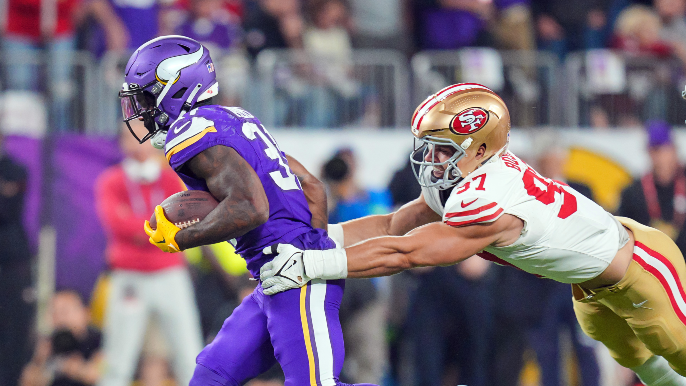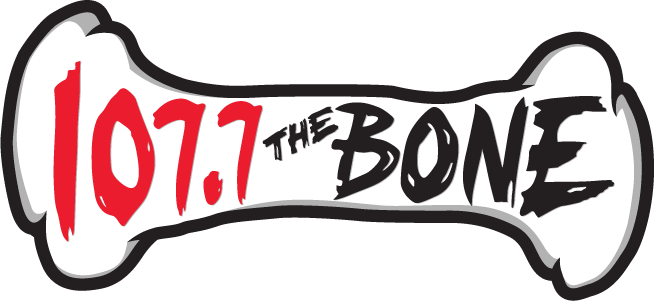
MINNEAPOLIS — Since the moment a then-gray-hair-free Kyle Shanahan took over the 49ers in 2017, his teams have been founded in their defensive line. Creating pressure with four down linemen is the bedrock of their identity.
The 49ers sacked Kirk Cousins zero times Monday night.
On the list of quarterbacks San Francisco has and is scheduled to face this season, Cousins is the most immobile.
If you don’t buy that, here are the names, in order:
Kenny Pickett, Matthew Stafford (2X), Daniel Jones, Josh Dobbs, Dak Prescott, P.J. Walker, Kirk Cousins, Joe Burrow, Trevor Lawrence, Baker Mayfield, Geno Smith (2X), Jalen Hurts, Dobbs/Kyler Murray, Lamar Jackson, Sam Howell.
The purest pocket passer — and most stone-footed — of that group was not sacked a single time.
That cannot happen. If that trend continues, it will damn this season for the 49ers. It will be a death-knell.
San Francisco needs answers, and the most pathetic part of Monday’s performance — after a similarly poor one against the Browns — was that they lacked them.
A few things happened Monday, upon re-watch:
- There were an abundance of screens and short passes, especially early, which prevented pressure opportunities, and set up the expectation for more screens
- Kirk Cousins delivered the ball quickly, rarely giving the 49ers an opportunity to pressure him
- When pressured, Cousins delivered
- Minnesota’s protection scheme was heavy, and involved multiple chips and double teams on almost every snap
- The protection unit was able to hand off double-teams, so that when a dangerous one-on-one arose, a lineman usually handed off their assignment to create a new double team
- The weakest links of the 49ers’ pass rush didn’t get home, and sometimes their stars didn’t, either
- San Francisco’s blitzes were mostly futile, and Cousins delivered when they came his way
- The defensive front was predictable, only running a handful of stunts
Per Brad Spielberger of PFF, they amassed a (pending review) 15.6 percent pass rush win rate, which would be their worst since 2017.
Because of the 49ers’ failure to win up front, Steve Wilks opted for those blitzes, but they were woefully ill-timed.
One, a six-man blitz off the right side of the Vikings’ offensive line, was as poorly timed a call as any all game, from either team. It was against a screen to the right, allowing Cam Akers to rumble down to the 2-yard line with a couple defenders cleared out.
Another six-man blitz allowed that embarrassment of a Jordan Addison touchdown that he stole from the clutches of Charvarius Ward. With 16 seconds left, it is almost impossible to understand the logic in that call.
Kyle Shanahan seemed displeased when asked about that blitz.
“That’s something to discuss throughout this week,” Shanahan said. “Obviously, I did not like to result.”
Nick Bosa admitted that he’s not quite used to the blitz calls.
“It definitely works out sometimes,” Bosa said. “I’m not used to it. We’re usually a ‘rush four’ kind of team and it’s a little different this year.”
The 49ers should be able to rush four and get home.
They have an outrageous defensive front. Just follow the money.
Here are the most recent contracts handed out to members of the 49ers’ defensive line based on average annual value. Keep in mind the 49ers are not paying all of this money, (especially to Randy Gregory, whose contract is largely paid by the Denver Broncos, and who the 49ers are paying $840,000 this season).
But there are four high-value players, sorted by average annual value (AAV):
- Nick Bosa: Five years, $170 million ($34 million AAV)
- Javon Hargrave: Four years, $81 million ($20.25 million AAV)
- Arik Armstead: Five years, $85 million ($17 million AAV)
- Randy Gregory: Five years, $70 million ($14 million AAV)
- Javon Kinlaw: Four years, $15.49 million ($3.87 million AAV)
- Clelin Ferrell: One year, $2.46 million
- Kevin Givens: One year, $2 million
- Drake Jackson: Four years, $5.89 million ($1.47 million AAV)
- Kalia Davis: One year, $783,003
That’s a combined average annual value of more than $95 million, which would be the 20th-highest payroll in Major League Baseball this season. It’s also just enough to buy you a cute, two-bedroom, one bath in Cole Valley. It does not come with air conditioning.
Armstead ($11.975 million, 2nd), Bosa ($11.01 million, 3rd) and Hargrave ($6.595 million, 7th) have three of the top-seven highest cap hits on the 49ers’ roster this season.
There is definite blame on their part, but for the most part, the Vikings out-schemed them.
There’s enough talent on that line to pressure Cousins, but when the front rushes nearly the same way every snap, it’s easy for the offense to have answers.
Much will understandably be made of Bosa’s salary and his 2.5 sacks on the season, but Minnesota gave him very few chances to get after Cousins, and in his one-on-ones, he was effective.
When they didn’t chip or slide an extra man his way, they often confused him.
They dialed up, like Cleveland, an abundance of screens. There are multiple times when Bosa gets chipped, and then freezes like he’s expecting a screen. He even made a coverage tackle on T.J. Hockenson in the second half.
As for the other two interior pieces, Javon Hargrave and Arik Armstead were frequently double-teamed. Hargrave was far more effective than Armstead in both the pass and run game, with Armstead getting stood up and out-leveraged much more often than he usually does.
And at the other defensive end spot? Randy Gregory and Clelin Ferrell both got home a couple times, but not regularly. They, too, faced double teams, as did Drake Jackson, who was the least effective of the three.
It has to be stated that Minnesota has an elite offensive line, ranked third in pass blocking by PFF, with the 2nd-(Christian Darrisaw) and 7th-ranked tackles (Brian O’Neill) and 3rd-ranked center (Garrett Bradbury). They just added veteran guard Dalton Risner to the weakest spot on that line, left guard.
That’s a stellar group, but one which, more than anything, had a blueprint that the 49ers did not have answers for.
The Vikings had outstanding communication on the offensive line and a plan that was clearly aligned at all levels of the offense, from Kevin O’Connell, to Kirk Cousins, to the fullbacks, tight ends and offensive linemen. Assignments were passed off and adjustments made on the fly to account for whoever the 49ers sent.
Other teams will take notice.
Arguably the bigger issue was the 49ers’ predictability and struggles in coverage.
It seemed like just about every crossing route resulted in an offensive win, and when there was an inch, Cousins took advantage of it. At one point, he split both Fred Warner and Dre Greenlaw to thread the needle to T.J. Hockenson. He had some high-profile red zone misses, and should have been picked off twice by Ward, but was otherwise surgical.
He finished 35-of-45 with 378 yards, 2 TDs and an INT .
But again… no sacks.
There is far too much talent on this defense to allow a quick passing game, double teams and screens to bludgeon it. But that’s roughly what’s happened the last two weeks.
Steve Wilks will need to go back to the drawing board and figure out what the answer is. More of the five-man front? More twists on the interior, maybe in the vein of how Charles Omenihu and Arden Key were used (and which was used, by my count, once against Minnesota)? More coverage disguises and fake A-gap blitzes?
These are a handful of the methods that proved effective in the past. It is Wilks’ and his staff’s job to find the answers.
This game was a clinic in offensive passing protection and provided tape in how to pick apart the San Francisco defense.
If the defense doesn’t adjust immediately, and show the capacity to change during the game — that part is crucial — this will keep happening.

